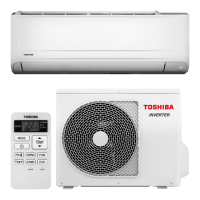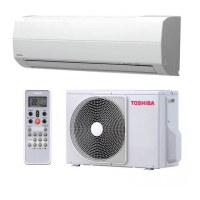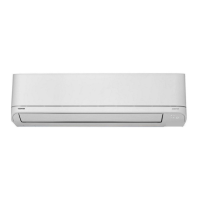Do you have a question about the Toshiba RAS-13SA-E and is the answer not in the manual?
Detailed diagrams and dimensions of the indoor unit components and assembly.
Detailed diagrams and dimensions of the outdoor unit components and assembly.
Technical specifications for electrical components used in the indoor unit.
Technical specifications for electrical components used in the outdoor unit.
Describes the functionality and air volume control for FAN ONLY mode.
Explains the compressor, fan, and display control for COOL operation.
Details how to set and control the louver position and swing.
Explains the compressor and fan operation during DRY mode.
Describes the automatic selection of cooling or dry modes based on room temperature.
Explains the temporary auto mode with a fixed 24°C set temperature.
Describes the energy-saving mode that reduces fan speed and noise.
Explains how the system prevents freezing of the indoor heat exchanger.
Details the automatic restart feature after a power outage.
Step-by-step guide on how to enable the auto restart function.
Instructions on how to disable the auto restart function.
Explains how power failures affect timer operations with auto restart.
Critical safety warnings and precautions for installation personnel and users.
Visual guide showing the placement and connection of indoor and outdoor units.
Lists optional and required parts for the installation process.
Procedures for selecting the installation location and preparing the indoor unit.
Steps for drilling wall openings and mounting the indoor unit's installation plate.
Guidelines for connecting the unit to the power supply, including voltage and wiring.
Detailed instructions for connecting the indoor unit's wiring.
Steps for installing refrigerant pipes and the drain hose for the indoor unit.
Instructions on how to physically attach the indoor unit to the wall plate.
Procedures for ensuring proper water drainage from the indoor unit.
Guidelines for selecting the installation location for the outdoor unit.
Steps for connecting the refrigerant pipes between indoor and outdoor units.
Procedure for evacuating air from the refrigerant lines using a vacuum pump.
Instructions for connecting the electrical wiring to the outdoor unit.
Covers gas leak testing, test operation, and auto restart setup.
Method for checking for refrigerant leaks at connection points.
Performing test run to verify installation and operation.
Configuring the auto restart function after installation.
Initial checks for common issues like power supply and cable connections.
Identifying the likely faulty component based on symptoms and displays.
Explains the functions of the indoor unit's control system.
Interpreting self-diagnosis error codes displayed on the indoor unit.
Step-by-step diagnostic guides for specific operational problems.
Flowchart for diagnosing issues when the unit does not power on at all.
Troubleshooting specific to power issues after replacing the indoor PC board.
Flowchart for diagnosing when the outdoor unit fails to operate.
Flowchart for diagnosing when only the compressor fails to operate.
Flowchart for diagnosing when only the outdoor fan fails to operate.
Flowchart for diagnosing when only the indoor fan fails to operate.
Steps to diagnose problems with the remote control and indoor PC board.
Procedures for inspecting and testing the printed circuit board.
Diagrams showing the layout of components on the PC board.
Method to alter the operation time of the anti-restart timer.
Step-by-step guide for disassembling and replacing indoor unit components.
Procedures for replacing the microcomputer and related parts.
Procedures for replacing components within the outdoor unit.
Illustrated breakdown of the indoor unit with part numbers.
Illustrated breakdown of the outdoor unit with part numbers.
| Type | Split System |
|---|---|
| Cooling Capacity | 3.5 kW |
| Heating Capacity | 4.0 kW |
| Refrigerant | R410A |
| Power Supply | 220-240V, 50Hz |
| Energy Efficiency Ratio (EER) | 3.21 |
| Indoor Unit Dimensions (HxWxD) | 275x790x205 mm |
| Indoor Unit Weight | 9 kg |
| Noise Level (Outdoor) | 50 dB(A) |











